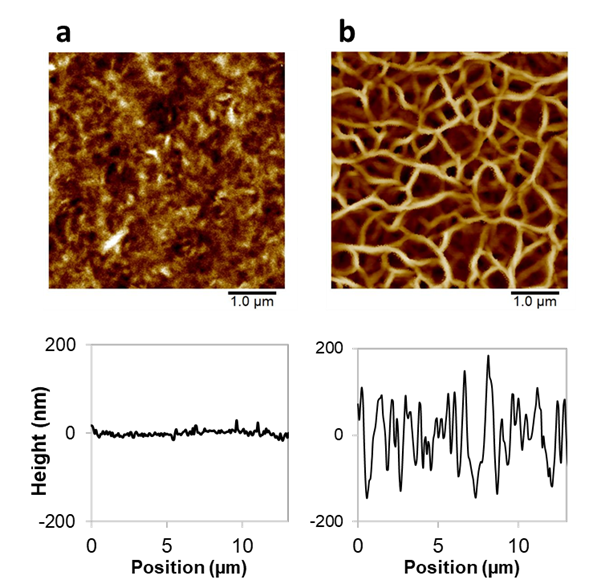Thermal-Induced phase separation in P18MA polymer brushes
Thermoresponsive coatings, such as P18MA brushes, are particularly intriguing due to their ability to respond dynamically to temperature changes. Below their melting transition, these brushes remain in a rigid, semicrystalline configuration, preventing interaction with ambient fluids. However, when heated above their melting transition, they absorb oil and swell, exhibiting a pronounced environmental response. Preliminary experiments have shown that upon cooling below the melting transition in the presence of a solvent, the brush architecture undergoes a distinct morphological rearrangement. This behavior is hypothesized to arise from phase separation dynamics: at temperatures above the melting point, oil acts as a good solvent, allowing the polymer and oil to mix. As the system cools, phase separation occurs between the polymer and the solvent, gradually reorganizing the structure until crystallization stabilizes and immobilizes the system. In this project, you will experimentally investigate this phase separation hypothesis. Using techniques such as Quartz Crystal Microbalance with Dissipation (QCM-D), you will monitor the morphological and dynamic changes in P18MA brushes as they interact with n-alkanes during the cooling process. This analysis will provide critical insights into the phase behavior of semicrystalline polymer brushes and their interactions with oils.
Fig 1. AFM topographic images of the dry P18MA brush surface and respective cross sections.
a. The surface appears smooth before exposure to the solvent, reflecting its initial morphology. b. After cooling in the presence of the solvent, the surface becomes noticeably rougher, indicating significant morphological changes. The image was captured after the solvent had evaporated.
Research objective
This study aims to investigate the thermal behaviour and phase transitions of P18MA polymer brushes in the presence of liquid n-alkanes (e.g., hexadecane) using Quartz Crystal Microbalance with Dissipation Monitoring (QCM-D). By monitoring frequency shifts (Δf), which correlate with absorbed mass, and changes in energy dissipation (ΔD), which provide insights into the surface layer's softness or rigidity, we can track the dynamic transitions of the brush. Specifically, we aim to detect a sudden change in the brush's rigidity upon heating above its melting temperature, while the absorbed mass remains constant. Moreover, QCM-D will help identify the system’s Upper Critical Solution Temperature (UCST) or Lower Critical Solution Temperature (LCST), if present, offering valuable insights into the thermal responsiveness and phase behaviour of the polymer-brush-solvent interaction.
Learning objective
- Understand the properties and behaviour of thin polymer films, with a focus on
semicrystalline polymer brushes
- Gain insight into polymer-solvent interactions and the mechanisms of phase separation
in polymer systems
- Learn to operate the Quartz Crystal Microbalance with Dissipation Monitoring (QCM-D)
- Develop skills in analysing QCM-D data, interpreting mass and energy dissipation changes,
and correlating these to the physical properties of the polymer brush.
Daily supervisors: Luciana Buonaiuto, Sander Reuvekamp
